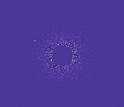News Release 08-204
Planetary "First Family" Discovered By Astronomers Using Gemini and Keck Observatories
First direct images of a planetary familly around a normal star observed

Artist's conception of the multiple planet system, initially discovered with Gemini North optics.
November 13, 2008
This material is available primarily for archival purposes. Telephone numbers or other contact information may be out of date; please see current contact information at media contacts.
Astronomers using the Gemini North telescope and W.M. Keck Observatory on Hawaii's Mauna Kea, the tallest mountain in the Hawaiian chain, have obtained the first-ever direct images identifying a multi-planet system around a normal star.
The Gemini images allowed the international team to make the initial discovery of two of the planets in the confirmed planetary system with data obtained on Oct. 17, 2007. Then, on Oct. 25, 2007, and in the summer of 2008, the team, led by Christian Marois of the National Research Council of Canada's Herzberg Institute of Astrophysics in Victoria, British Columbia, and members from the U.S. and U.K., confirmed this discovery and found a third planet orbiting even closer to the star with images obtained by the Keck II telescope. These historic infrared images of an extra-solar multiple-planet system were made possible by adaptive optics technology used to correct in real time for atmospheric turbulence, the shimmering or blinking of starlight as it passes through the earth's atmosphere.
"This discovery is significant--it is the first time a family of planets around a normal star outside of our solar system was imaged," said Brian Patten, program manager at the National Science Foundation. "Scientists may now directly view planets themselves, as opposed to indirectly through a star's spectrum or its brightness."
Research results will be published in the Nov.13, 2008, issue of Science Express, an international weekly science journal.
The host star, a young, massive star called HR 8799, is about 130 light years away from Earth. Comparison of multi-epoch data shows that the three planets are all moving with, and orbiting around, the star, proving that they are associated with it rather than just unrelated background objects coincidentally aligned in the image.
The planets, which formed about 60 million years ago, are young enough that they are still glowing from heat released as they contracted, making them easier to see in infrared light. Analysis of the brightness and colors of the objects at multiple wavelengths shows that these objects are about seven and 10 times the mass of Jupiter. As in our solar system, these giant planets orbit in the outer regions of this system--at roughly 25, 40, and 70 times the Earth-Sun separation. The furthest planet orbits just inside a disk of dusty debris, similar to that produced by the comets of the Kuiper Belt objects of our solar system just beyond the orbit of Neptune at 30 times the Earth-Sun distance. In some ways, this planetary system seems to be a scaled-up version of our solar system orbiting a larger and brighter star.
HR 8799 observations are part of a survey of 80 such young, dusty, and massive stars located in the solar neighborhood. The survey is using adaptive optics systems at Gemini, Keck and VLT in Chile to constrain the Jupiter-mass planet populations in a range of separations inaccessible to other exoplanet detection techniques. This discovery was made after observing only a few stars, which may lead to the conclusion that Jupiter-mass planets at separations similar to the giant planets of our solar system are frequent around stars more massive than the Sun, Marois said. "HR 8799's planetary system will be studied in great detail in the years to come, and it will surely be a prime target for future next-generation, exoplanet finding instruments and dedicated space missions."
About the Gemini Observatory
The Gemini Observatory is an international partnership involving the United States, the United Kingdom, Canada, Australia, Chile, Brazil and Argentina. The partnership has constructed and now operates two 8-meter telescopes: one in the Northern Hemisphere on Mauna Kea, Hawaii, and one in the Southern Hemisphere on Cerro Pachon, Chile. The twin telescopes are infrared-optimized, have superb image quality, and provide unprecedented optical and infrared coverage of the northern and southern skies for astronomical research. Scientific operations began on Gemini North in 2000 and on Gemini South in 2001.
NSF acts as the executive agency for the partnership, and the Association of Universities for Research in Astronomy Inc.--a consortium of 33 U.S. universities and institutions and seven international affiliates--manages the Gemini Observatory. The Astronomy Division also provides the U.S. share of funding for the operation of the observatory.
-NSF-
-
Gemini Observatory discovery image using the Altair adaptive optics system on Gemini North.
Credit and Larger Version
Media Contacts
Lisa-Joy Zgorski, NSF, (703) 292-8311, email: lisajoy@nsf.gov
Peter Michaud, Gemini Observatory, Hilo, HI, (808) 974-2510, email: pmichaud@gemini.edu
Program Contacts
Brian M Patten, NSF, (703) 292-4910, email: bpatten@nsf.gov
Co-Investigators
Bruce Macintosh, Lawrence Livermore National Laboratories, Livermore, CA, (925) 423-8129, email: macintosh1@llnl.gov
Related Websites
Gemini Observatory, Hilo, Hawaii: http://www.gemini.edu
The U.S. National Science Foundation propels the nation forward by advancing fundamental research in all fields of science and engineering. NSF supports research and people by providing facilities, instruments and funding to support their ingenuity and sustain the U.S. as a global leader in research and innovation. With a fiscal year 2023 budget of $9.5 billion, NSF funds reach all 50 states through grants to nearly 2,000 colleges, universities and institutions. Each year, NSF receives more than 40,000 competitive proposals and makes about 11,000 new awards. Those awards include support for cooperative research with industry, Arctic and Antarctic research and operations, and U.S. participation in international scientific efforts.
Connect with us online
NSF website: nsf.gov
NSF News: nsf.gov/news
For News Media: nsf.gov/news/newsroom
Statistics: nsf.gov/statistics/
Awards database: nsf.gov/awardsearch/
Follow us on social
Twitter: twitter.com/NSF
Facebook: facebook.com/US.NSF
Instagram: instagram.com/nsfgov

